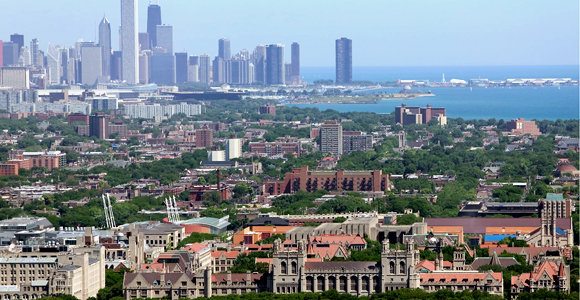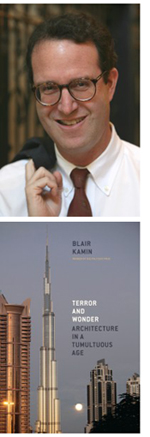| Sun | Mon | Tue | Wed | Thu | Fri | Sat |
|---|---|---|---|---|---|---|
| 1 | 2 | 3 | 4 | 5 | ||
| 6 | 7 | 8 | 9 | 10 | 11 | 12 |
| 13 | 14 | 15 | 16 | 17 | 18 | 19 |
| 20 | 21 | 22 | 23 | 24 | 25 | 26 |
| 27 | 28 | 29 | 30 | 31 |
CATEGORIES
RECENT ENTRIES
BLOG ROLL
Critical distance
Architecture critic Blair Kamin isn’t ready to rate the University’s latest building projects—but his new book dissects a decade of changes to Chicago’s cityscape.

We’re only ten years into the 21st century, but between the Great Recession and Mayor Daley’s imminent departure, the city of Chicago has reached the end of an architectural era. Blair Kamin, the Chicago Tribune’s Pulitzer Prize–winning architecture critic, chronicles the building boom and more in Terror and Wonder: Architecture in a Tumultuous Age, just published by the University of Chicago Press. In a recent e-mail interview, Kamin reflected on a period “bracketed by two great thunderclaps in the sky”—the destruction of the World Trade Center in 2001 and the opening of the Burj Khalifa, the world’s tallest building, in 2010.
With 9/11 and the fall of the twin towers, we saw a nationwide push to secure buildings and public spaces. But Chicago also had a skyscraper building boom. How did this shift from “terror to wonder” happen?
May I restate the question? I think that’s in order because so many new Chicago skyscrapers are not wonderful but awful. They look as though they were designed by refugees from East Germany. What you’re really asking, I think, is this: How could we have had such disparate, post 9/11 reactions—the security clampdown on the one hand and the exuberant building boom on the other?
Here’s why: Many of the security measures were necessary, even though far too many of them, like those endless lines at O’Hare and Midway, made us feel like cattle at the old Chicago Stockyards. But the September 11 attacks did not eradicate the profit motive. People build skyscrapers to make money. And build they did once the post-9/11 fear of heights ebbed. All the talk about “the end of the skyscraper” proved as unfounded as the post-September 11 predictions about “the end of irony.” Eventually, the pundits who forecast irony’s demise had to backtrack and say that they had really been talking about “the end of ironing.”

What are the architectural success stories of Chicago’s boom years?
There are many, starting with Jeanne Gang’s Aqua, an 82-story hotel and residential high-rise just north of Millennium Park. Its striking, undulating balconies bring the samba élan of Brazil to Chicago’s sober grids and rectangles. Millennium Park, with its interactive public sculptures like Cloud Gate and the Crown Fountain, is the great urban space of the decade. Yet the most significant development might turn out to be Mayor Richard Daley’s push for energy-saving, “green architecture.” Daley ruled with an iron fist and a green thumb.
Any notable flops or missed opportunities?
I could write a book about them—no, wait, I just did. Far too many of the residential high-rises that went up early in the decade were examples of what I call “plop architecture.” They saddled the cityscape with bland tops plunked atop brute bottoms, or podiums, that housed enormous parking garages. Here, Chicago utterly lost its legendary ability to marry utility and beauty. Also marring the cityscape: The renovated Soldier Field and its inglorious, Klingon-meets-Parthenon mismatch of classicism and modernism.
You write about ways new buildings “converse” with their surrounding neighborhoods—and you’ve praised Millennium Park as an urban space that gathers people of diverse classes and races. How does the University of Chicago converse, architecturally, with Hyde Park and the rest of the city?
It’s a dialogue of opposites. The U of C’s serene quads turn inward; they hold the wild, disorderly city at bay. And their neo-Gothic architecture, with its picturesque irregularity (all those playful grotesques and gargoyles), couldn’t be more different from the regularized, bare-boned beauty of early Chicago skyscrapers like the Marquette Building or such mid-20th century masterpieces as the X-braced John Hancock Center. The U of C’s architecture is elegant, almost feminine. The city of Chicago’s architecture is brutally straightforward and very macho. I love them both.
Can you share your impressions of the Mansueto Library, Logan Center for Performing and Creative Arts, the Midway light bridge, or other 21st-century building projects on the UChicago campus?
All represent bold, modern departures from the neo-Gothic norm, but I’m not prepared to offer any assessments because the projects are either nearing completion or their construction is underway. To get your answer, you’ll have to read my review.
Has the recession put an end to what you’ve called the “age of excess”? How will new building plans reflect a new era, in Chicago and elsewhere?
The built environment will invariably be affected by the shift from “the age of excess” to “the age of austerity.” Say goodbye to all those flashy museums that were big on bling. Clients won’t have the money to build them and even if they did, they wouldn’t want to look flashy. Doing so would seem out of sync with the new zeitgeist. Frugal is the new black. Unless we’re talking buildings for deep-pocketed health care and higher-education clients, the major new projects will be renovations, like the upcoming revamp of Navy Pier. And even those will have modest budgets. The years of the big architectural blow-out are over.
Elizabeth Station
November 24, 2010
